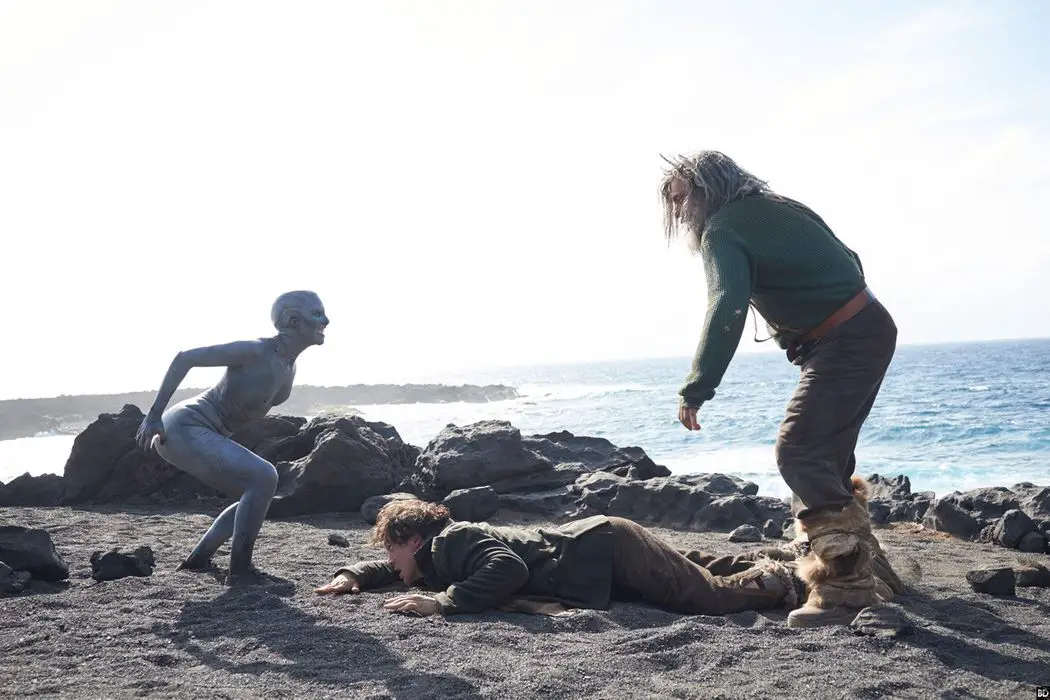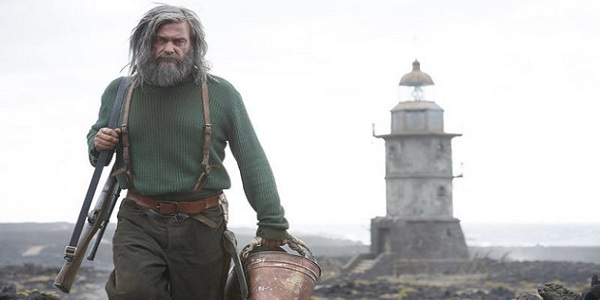COLD SKIN: Erratic Storytelling Leaves An Intriguing Tale Of Human Connection Rather Numb

Charlie Nicholson has written about films and other media since…
The most frustrating thing about Xavier Gens’ Antarctic monster movie is its indecisiveness. A hotbed of promising ideas, Cold Skin swings erratically between visceral action, thoughtful science-fiction and psychological drama, so insistent upon pursuing all that it breaks down in terms of storyline. Sadly (often heartbreakingly, considering its technical competence), Cold Skin is stifled by its own enthusiasm, providing ultimately a surface-level concept film with no coherent structure.
Frozen Beauty
Cold Skin appears primarily concerned with the fantasy and science fiction genres, which makes sense given screenwriters Jesús Olmo and Eron Sheean are drawing from Albert Sánchez Piñol’s 2002 Catalan novel La pell freda.
The set-up is reasonably faithful. Following the First World War, a young man named Friend (David Oakes) travels to a secluded island somewhere in the Southern Atlantic, to work as a meteorologist after the previous one has allegedly died of typhus. Before long, Friend (whose name never really stops raising eyebrows) meets Gruner (Divergent’s Ray Stevenson): the cantankerous, but hardy lighthouse keeper who is apparently the island’s only other inhabitant.

We open promisingly. Harsh Atlantic waves thump perpetually over crags and ridged rock; the sparse, volcanic landscape looms impressively through Daniel Aranyó’s sweeping wide angles. There’s an eerie supremacy to the island that challenges the protagonist’s own authority; instead, Friend appears a vulnerable observer upon a world with its own terms and whims.
Colour is beautifully rendered to emphasize this vulnerability. The perforating high-key light of the daytime island transforms quickly into the sputtering, lamplit interior of Friend’s cottage, mirroring the physical and perceptual strain that comes from a life of weathered solitude. It also applies a strong Lovecraftian overlay to the first act’s survival tale (staunched with frequent, if slightly unnecessary quotes from Piñol’s novel), displaying a fascination with psychological unhinge and humanity’s fear of the unknown. There are traces of Carpenter’s The Thing, for thermal extremes are constantly juxtaposed to simulate a relentless natural world. In its opening twenty minutes, Cold Skin builds a tension that absolutely feels right.
Structure Melts Beneath Oversaturated Storytelling
Having built this tension, Cold Skin then finds itself meandering aimlessly between genres in search of a satisfying payoff. Slow-burning drama becomes ostensible creature feature when Friend is attacked by a group of strange amphibian monsters, discovering the real reason for his predecessor’s death. We then decide we’re in an action film when Friend teams up with fellow islander Gruner, whom he discovers has domesticated one of the female creatures, Aneris, to make his sex slave. Between nightly barrages against oncoming hordes of creatures, Friend becomes intrigued by Aneris, placing Gruner’s apparent delight in culling these creatures under question.

The story that follows is part buddy action, part romance, part science-fiction, swinging impulsively between the two men’s strained relations, and Friend’s increasing awe for the creatures he routinely murders. Aura Garrido brings fierce physicality to the mystical Aneris, and (though lacking the subtlety to suggest she is in anything other than a casual monster movie) shows not the slightest sign of encumberment beneath quite beguiling prosthetics.
Ray Stevenson is also commendable as the grizzled Gruner; unquestionably antagonistic, he plays the abusive slaver with a demented energy, bordering on pulp horror just enough to distract from a wobbly character arc. And like Del Toro’s The Shape of Water, the glimmers of understanding between Aneris and Friend can be endearing when played against Gruner’s grizzled intolerance; brief moments of respite from a world of grim oppressors.

But the comparison is only skin deep. The Shape of Water developed its central relationship into a wider appraisal of the genre film, whereas in Cold Skin it merely floats around in a soup of genre tropes. The ending exemplifies this; though discussing details would be to spoil what is still a marvellous piece of Gothic imagery, it frustrates to see how much it is marred by inconsistent character decisions and frantic attempts to tie things up.
Conclusion: Cold Skin
Cold Skin isn’t necessarily a poorly made film. The eternally cold palette and sweeping establishing shots demonstrate easily a talent for world-building, and perceivable within it are the beginnings of a thoughtful tale of finding connection amidst crippling isolation.
But those beginnings are stifled by poor narrative construction. Though beginning along the haunting path laid by the artful landscape, Gens becomes distracted as further opportunities arise, which ultimately arrives in a hotchpotch of half-hearted decisions and inconsistent tropes.
Genre fans will quite likely delight in the detailed creature effects (I know I did), and the first act carries some incredible moments of psychological tension. Still, those moments become fewer and fewer as character relationships spiral into a convoluted mess, and it’s a shame that the final feeling Cold Skin leaves the viewer with is indifference.
What did you think of Cold Skin? Did the story resonate with you, or did you connect more with the visual elements? Let us know your thoughts in the comments below.
Cold Skin released on March 2 in the U.K. and is scheduled to release on September 7 in the U.S. All international release dates can be found here.
https://www.youtube.com/watch?v=rwdojcKHAFA
Does content like this matter to you?
Become a Member and support film journalism. Unlock access to all of Film Inquiry`s great articles. Join a community of like-minded readers who are passionate about cinema - get access to our private members Network, give back to independent filmmakers, and more.
Charlie Nicholson has written about films and other media since 2015, and is approaching his third year studying Film and English Literature at the University of East Anglia. His work can be found on New Game Network, The Independent and Concrete. When he's not expanding his coming-of-age library or buried in a video game, you'll probably find him working on some diorama inspired by eighties-era fantasy. He's also never quite managed to shake his childhood fear of the Gmork. Follow him @Charcolson













